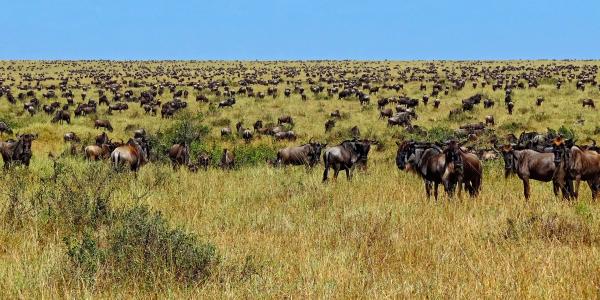To help elucidate the many roles of parasites in the environment, postdoctoral scholar Amanda Koltz will convene a working group of disease and ecology experts this winter. The work is supported by WashU's Living Earth Collaborative.
What do wolves, sharks, and the rinderpest virus have in common?
Answer: Though they may not all be the stuff of children’s nightmares, all three are predators.
Much is known about the roles of top predators like wolves and sharks in the ecosystems they inhabit, but the roles of parasites – which may be equally important – are less understood. So, how, mechanistically and quantifiably, do parasites affect the broader ecosystem? And how might their roles change as the environment itself changes?
Amanda Koltz, a postdoctoral scholar in the Department of Biology, and her collaborators hope to chip away at this monstrous question by convening a working group of some of the world’s top researchers in the fields of ecology, parasitology, and epidemiology. The group plans to focus on diseases within ungulates, hoofed mammals that roam nearly every corner of the globe, to home in on some answers.
“In a lot of ways, a disease or parasite is similar to a predator because they both acquire resources from their prey and have negative impacts on prey populations,” said Koltz. “Predators and parasites also influence prey ecology, behavior, and physiology, which can have cascading effects on the ecosystem. It’s especially important for us to consider these broader ecosystem-level consequences of changing disease dynamics in the context of increasing losses to biodiversity and other forms of disturbance like climate change.”

ungulate populations, was eradicated in the
early 2000s.
The textbook predator-prey-ecosystem relationship – or trophic cascade – goes something like this: Eagles, rabbits, and grass exist together in an ecosystem. If you take away the eagle, rabbits proliferate and eat all the grass; eventually the rabbits die out as well. Parasites can also fit into a similar framework: Eradicating the rinderpest virus in the Serengeti ecosystem, for example, caused a surge in the wildebeest population, which dramatically altered carbon storage and other physical characteristics of the ecosystem. In general, sick animals can also consume plants, deposit waste, and reproduce at different rates than healthy animals.
“The aim of our working group is to address the ecosystem-level consequences of changing disease dynamics,” said Koltz. “We’re trying to think about disease in the context of energy and nutrients moving through the ecosystem.”
The group chose to focus on ungulates because they are widely distributed, thriving in nearly every biome across the planet. They also occupy key positions in the food web, both as primary consumers (eating grass and other photosynthetic organisms at the base of the food web) and as prey for predators, or secondary consumers. Ungulates’ relatively large size means they have a large impact on their ecosystems in terms of the amounts of vegetation they consume and waste they leave behind. And because both wild and domestic populations are economically important, their diseases and parasites are widely documented in scientific literature.
Koltz and her collaborators – who are experts in theoretical ecology, epidemiology, ecosystem ecology, veterinary sciences, and aquatic and terrestrial disease ecology – will convene as a working group to sort through the large body of data on ungulate parasites and ecosystem impacts. They hope to develop a conceptual modeling framework for merging these various fields of study, as well as an extensive database of ungulate hosts and parasites. The ten members of the working group will meet twice – first in December and again in the spring – with collaborations likely continuing beyond the first year of seed funding.
“My expertise is working with predators and prey, and so disease is a natural extension of that,” said Koltz. “Parasites are fun to think about because there are so many, they’re everywhere – and you have to admit – they’re kind of gross. But more than that, they could have an important role within the larger ecosystem. And the gross part is fun, too.”
Koltz's project is supported by a grant from the Living Earth Collaborative, a new center for biodiversity that brings together scientists from WashU, the Missouri Botanical Garden, and the St. Louis Zoo. Other members of the team include Rachel Penczykowski, assistant professor in the Department of Biology; Sharon Deem, director of the Institute for Conservation Medicine at the Saint Louis Zoo; and Vanessa O. Ezenwa, professor of ecology and infectious diseases at the University of Georgia.





